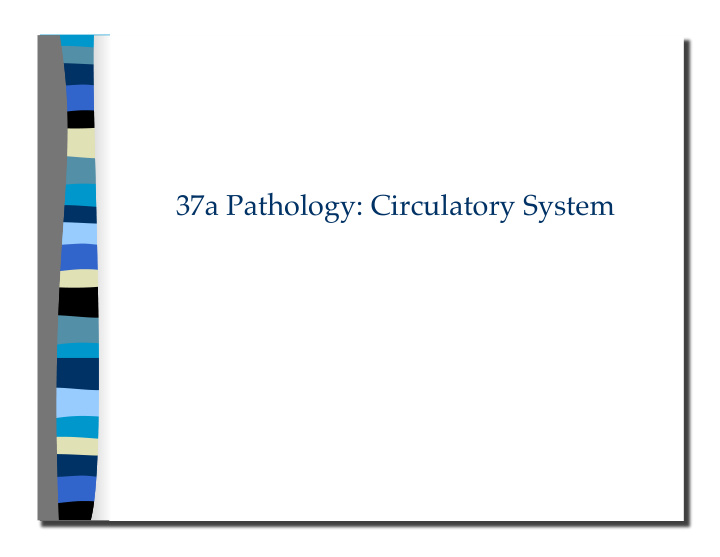



37a Pathology: Circulatory System
37a Pathology: Circulatory System � Class Outline � 5 minutes � � Attendance, Breath of Arrival, and Reminders � 10 minutes � Lecture: � 25 minutes � Lecture: � 15 minutes � Active study skills: � 60 minutes � Total �
37a Pathology: Circulatory System � Class Reminders � Assignments: � 37b Purpose, Priorities, and Goals (B: 6-8) � � 41a Review Questions (A: 149-162) � � 43a Swedish: Outside Massages � � Quizzes: � 42a Written Exam Prep Quiz (35a, 36a, 37a, 38a, 39a, 40a, and 41a) � � 42b Kinesiology Quiz � � – adductor magnus, gracilis, iliopsoas, sartorius, TFL, piriformis, quadratus femoris � 44a Written Exam Prep Quiz (33b, 37b, 41b, 42b, and 43a) � � Preparation for upcoming classes: � 38a A&P: Lymphatic System and Immunity � � – Trail Guide: sartorius and TFL � – Salvo: Chapter 27 � – Packet E: 73-76 � – Packet A: 155-156 � 38b Body Mobilization Techniques: Technique Demo and Practice - Prone � � – Packet F: 79-82 �
Classroom Rules � Punctuality - everybody’s time is precious � Be ready to learn at the start of class; we’ll have you out of here on time � � Tardiness: arriving late, returning late after breaks, leaving during class, leaving � early � The following are not allowed: � Bare feet � � Side talking � � Lying down � � Inappropriate clothing � � Food or drink except water � � Phones that are visible in the classroom, bathrooms, or internship � � You will receive one verbal warning, then you’ll have to leave the room. �
37a Pathology: Circulatory System � Packet E-71
Blood Disorders
Blood Disorders Anemia Shortage of red blood cells or hemoglobin that limits oxygen carrying capacity. May cause fatigue, pallor, dyspnea, rapid heartbeat, intolerance to cold or heart problems. �
Blood Disorders Embolus Traveling clot or collection of debris. May cause blockage in lungs (if originating on the venous side) or brain, heart, kidneys or legs (if originating on the arterial side). � Embolus
Blood Disorders Embolism The occlusion of a blood vessel by an embolus. �
Blood Disorders Thrombus Blood clot formed in the wall of an artery or vein. If it breaks loose it becomes an embolus, and may lodge in the lungs, brain, heart, kidneys or other places. �
Blood Disorders Hemophilia Collection of genetic disorders. Absence of plasma proteins that are crucial in the clot-forming process puts a person at risk of serious complications due to inability to clot in normal amount of time. �
Blood Disorders Leukemia Cancer that affects bone marrow cells, causing overproduction of non-functioning white blood cells. �
Blood Disorders Myeloma Blood cancer involving B cells maturing in bone marrow. �
Blood Disorders Sickle cell disease Faulty gene causes the production of short-lived and misshapen red blood cells. �
Blood Disorders Thrombophlebitis Blood clots obstructing superficial leg veins - usually involves inflammation. �
Blood Disorders Deep vein thrombosis (AKA: DVT) Blood clots obstructing deep leg veins - a more serious risk for embolism than thrombophlebitis - often occurs with no significant symptoms. �
Vascular Disorders
Vascular Disorders Aneurysm Permanent bulge in the wall of a vein, artery, or heart. Aortic or cerebral most common. Risk of rupture and internal bleeding. �
Vascular Disorders Atherosclerosis Arteries become inelastic, brittle, and hardened. May be compounded by local spasm and blood clot formation, increasing risk of thrombosis and embolism. �
Vascular Disorders Hypertension (AKA: high blood pressure) Persistently above 140/90. Can lead to edema, atherosclerosis, stroke, enlarged heart, aneurysm, kidney disease or retinopathy. �
Vascular Disorders Raynaud syndrome Episodes of vascular constriction followed by dilation of the arterioles, usually in the fingers and toes. Pain, numbness and /or tingling may follow. �
Vascular Disorders Varicose veins Permanently distended superficial leg veins, due to weakening of vessel walls and compromised valves. �
Heart Conditions
Heart Conditions Heart attack (AKA: myocardial infarction) Damage to the myocardium caused by obstructed coronary vessels. Dead cells are replaced by non-contractile scar tissue. � �
Heart Conditions Heart failure Progressive loss of cardiac function resulting in the heart not being able to keep up with the needs of the body. This may result in edema in the lungs, legs, or abdomen, enlarged liver, or renal failure. �
Heart Conditions Cardiac arrest Heart completely stops working. �
37a Pathology: Circulatory System
Recommend
More recommend